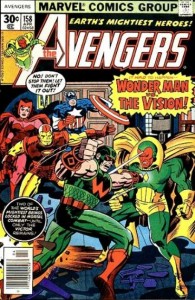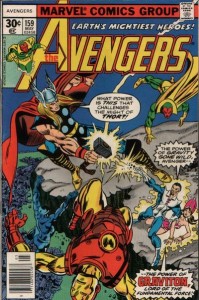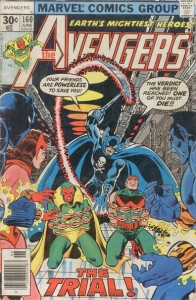(Total comic geekiness this week. No need to look within for any profound reflections on life. Sorry!)
I started reading Marvel’s premier team book, The Avengers (AKA, unofficially, The Mighty Avengers and sometimes The Avengers: Earth’s Mightiest Heroes) in 1974. I grew up with it as one of my top favorite comics. As I grew peripherally aware of who was writing the scripts, who was drawing the pictures, I came to see Jim Shooter’s first tour as author of the Mighty Assemblers’ adventures as something of a golden age for the team. But then, to be fair, I pretty much considered the entire run, from about ten issues after I started reading and figured out what was going on, to the time seven years later when I just felt I’d gotten too old for comic books, to be a golden age. (Too old for comic books at 15. I know, right? Y’see, there was this girl…)
But Jim Shooter, the still-very-young writer who, at age 13, had taken over DC’s Legion of Super-Heroes a few years earlier and made it a fan favorite, brought some very special moments to the team’s history, especially when he was working with George Perez, arguably the greatest artist ever to draw the Avengers. (And that’s saying something, when you consider they were also drawn by Neal Adams, Don Heck, John Buscema and Jack Kirby, to name a few.)
Shooter pitted the Avengers against some of their best villains (Ultron, The Lethal Legion, Count Nefaria, The Grim Reaper), teamed them with the Guardians of the Galaxy, and wrote a big, cosmic epic which featured every single person who’d ever been an Avenger as he introduced Michael / Korvac, the godlike being who was trying to take over the universe for the good of humanity. Granted, the ending on that story fizzled like a roman candle that’s been left out in the rain for a month, but it was a fun ride getting to the end.
So it was a shock, a handful of years later, when Shooter came back to the book and, well, bombed. Wrote one of the two or three worst runs of the entire series, counting the first 500+ issues of the original. (I don’t count what’s come since, as I’ve never read any of it. Sorry. If you need Wolverine and Spider-Man to sell an Avengers title, that should tell you your writing is weak.
Let me qualify one statement I made earlier: I said I gave up comics in 1981 because I thought I was too old for them. I came to that conclusion partially because I was reading them and not enjoying them. And that was partially because comics were evolving in a new direction, a direction I wasn’t completely comfortable with. Stories like those Jim Shooter was telling in his second coming on the book were indicative of that direction.
It’s always struck me as a bit strange that I would have so enjoyed 20+ issues by an author beginning in 1977, and then flat our despised six or so issues of the same title by the same author four years later.
So, when I sat down to read a volume of Avengers stories from the mid-1970s which includes the first six issues of Shooter’s run, I read his with an analytical eye.
Not surprising that the cracks began to show. Keep in mind that these are stories I read over and over again as a kid. Back then, I didn’t read a comic once and then throw it into a long box. I read it three or four times the first week I owned it, and then, and probably at monthly intervals, hauled out my entire collection of a title and read all its issues again. In 1977, if I was thinking about the Avengers, I could easily find the time to read the three dozen issues I owned. Sometimes in one day. (Those were the days!) My point is that I’ve read these stories so much that they’re engraved on my heart. Forty years later, I can still quote passages of dialogue from them.
So it’s not like I’m just going in to pick these stories apart because I want to dislike them. These things are the fabric of my childhood. And yet, here’s some of what I encountered, reading again:
 Issue 158: “When Avengers Clash!!”
Issue 158: “When Avengers Clash!!”
Shooter picks up where Conway left off, with Don Heck as his penciller. Heck had done the two previous issues with Conway, and was a veteran Avengers artist. He’d drawn the team for many issues in its early days. Conway and Heck had left the Vision doubting his own humanity in the wake of the appearance of Wonder Man, the allegedly dead human whose brain patterns had been used to create a personality in the Vision’s android brain. In Conway’s last issue, a soulless statue of the Black Knight, another Avenger, had been animated by persons unknown to attack the team. The statue thought it actually was the Knight, and it mocked the Vision for being artificial. The irony being that, well, so was the statue. Neither had a human “soul.”
In Shooter’s continuation, the Vision, standing over the fragments of his defeated foe, is confronted by the spectacle of his wife, Wanda the Scarlet Witch, dazed from battle, leaning on the shoulder of Wonder Man as she enters the room. (It’s a little bothersome that, when last seen battling the Stone Knight, this pair was in civvies. Now, still battle-fatigued, they’ve inexplicably donned costumes. Wouldn’t checking on their teammates take precedence over changing clothes?)
The Vision’s temper snaps, and he attacks Wonder Man. For several pages, we get a battle between these two. We expect this. It was promised by the cover. Iron Man (the team’s chairman) tells the Avengers to let them fight it out, then lets them fight it out… until he… doesn’t want to let them fight it out anymore. At which point he orders them to stop acting like children and bad houseguests. Um… yeah. Both the “fight it out” remark and the sudden, judgmental lecture hearken back to the worst aspects of the Legion of Super-Heroes, who were always, pre-Shooter and during Shooter’s time, prone to be holier-than-thou little douchebags. (I love the Legion, but you can’t deny this part of their character if you’ve read their 1960s adventures.)
And then the cover-story match is over, and we’re transported away from the Avengers Mansion and to a research facility in the Canadian Rockies, where we endure several pages of melodrama. A non-descript technician named Frank (who has a very evil goatee, of course) has gained control over gravity in a fairly generic “scientific mishap,” and is now holding his co-workers hostage while he sets up his own flying nation-state and claims the wife of a co-worker as his queen. Before we’re done here, Frank has ordered a flashy costume (from whence we don’t know… I guess Acme has a presence in the Marvel Universe) and dubbed himself Graviton.
Now, even as a kid, I felt cheated by this story. It felt like a fill-in issue to me. Even though it referenced events from the issue preceding it, and even though the battle between Vision and Wonder Man was completely character-driven, the issue felt… out of place. Generic may be the right term. Like someone had plugged some plotline meant for another team of heroes into the middle of an Avengers arc. Graviton always felt like a store-brand villain to me. You know, like the Safeway “Cola” that’s just not a Coke? He was created to fill time when the creative team couldn’t stretch the character piece to fill a whole issue. So it was baffling to me when he easily trounced the entire team of Avengers in the course of two or three pages when they arrived to investigate. As my little buddy Randy, who read the issue before I did, described it to me: “Gravitation (sic) used his powers and the Avengers got dead!!!” Randy’s description of the battle was more entertaining than the actual comic’s depiction of it.
 Issue 159: “Siege by Stealth and Storm”
Issue 159: “Siege by Stealth and Storm”
So the Avengers are defeated by a villain who doesn’t seem worthy of the honor, a Magneto rip-off without the mysterious, tragic past. And Thor and the Black Panther must return to bail them out. Just eight issues before, Thor had decided that a god on the team of mortals was out of place. It seems a little cheap, looking at these issues now, that he had to come back to help mop up after Cragmont Cola in a Cape. But clearly Shooter liked Thor and the Panther, so they were back. The Panther stayed permanently. I have no issue with that, though, as he’s also a favorite of mine. Not that Thor isn’t… I just thought it diminished all the other characters that they had to have the Thunder God’s help here. And his presence meant almost no screen time for the Vision, The Scarlet Witch, Yellowjacket, Wasp and the Beast, characters who had no other chance to appear in a story, as they didn’t have their own monthly titles.
BTW, I must concede a part of my argument to time, which has proclaimed that Graviton is not, in fact, uncool. He’s part of the plan for Marvel’s Agents of SHIELD, so… Yeah. Someone thinks he’s memorable.
Without question the best of the bunch–probably the best Avengers story Shooter ever wrote. The Grim Reaper returns. Eric Williams, the Grim Reaper, a villain who carried a scythe which put people in comas (and, in his first appearance, wasn’t very grim, as he was clad in magenta, royal blue and lime green… and possibly orange), had one goal: he wanted his brother Simon (Simon Williams was Wonder Man) either restored to him alive or he wanted the Avengers dead so that Simon could rest in peace. Over the years Eric tried various ways to re-animate Simon, including trying to transfer the Vision’s android consciousness into Simon’s preserved corpse, and paying a voodoo priest to make Simon a “zuvembie.” (It was against the Comics Code to use the word “zombie” in print.)
With Simon restored to apparent life, Eric faced a quandary. His life’s goal might be achieved, so now what? Well, to Eric’s twisted mind, the next move was simple: Put this alleged Simon Williams on trial to determine whether or not he’s the genuine article. If he’s not, he dies. If he is, Eric will kill the Vision, ’cause… you know… then he’s not necessary. The Grim Reaper really takes the cake as one of the all-time crazy villains.
The best thing about this issue, besides the Perez pencils and the focus on b-list characters (Thor, Captain America and Iron Man leave on page 2) is the fact that it neatly discharges the Vision’s year-long angst over whether or not he is a unique individual and entitled to live. After the “trial,” he stops whining and occasionally telling his wife that maybe he’s going to divorce her tomorrow. It was a relief.
So that’s a lot of words and I’ve only covered three issues. I’ll break here until next week. Three more issues to cover, and then some closing remarks.


Pingback: The change of illusion | Comics Madness